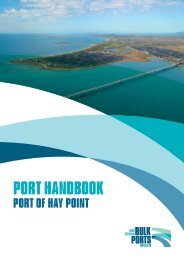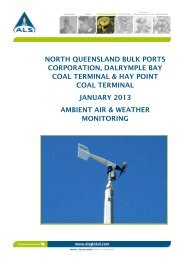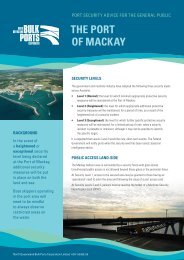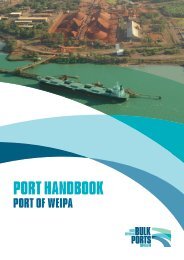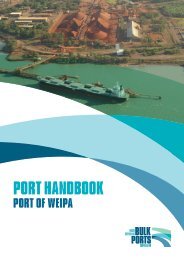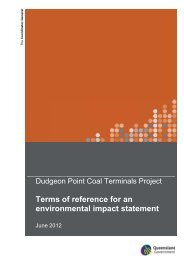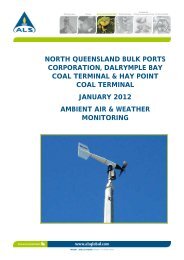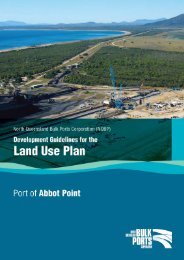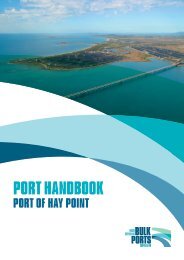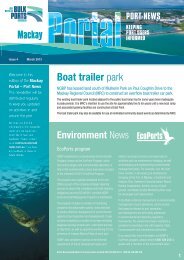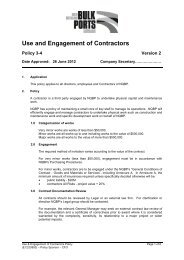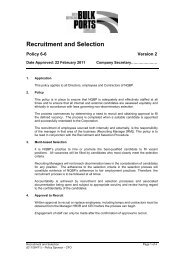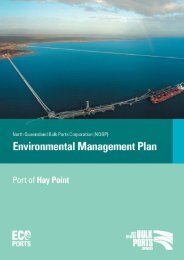Dudgeon Point Coal Terminals Project â Q and As - North ...
Dudgeon Point Coal Terminals Project â Q and As - North ...
Dudgeon Point Coal Terminals Project â Q and As - North ...
Create successful ePaper yourself
Turn your PDF publications into a flip-book with our unique Google optimized e-Paper software.
NQBP owns 1400 ha of l<strong>and</strong> at <strong>Dudgeon</strong> <strong>Point</strong>, with around 700 ha being allocated to conservation <strong>and</strong><br />
general buffer zones. The stockyard heights are expected to be similar to current terminals at Hay <strong>Point</strong>.<br />
Stockpile heights will be up to 15 m.<br />
Is any development proposed at the community of Louisa Creek?<br />
The proposed port expansion does not involve any terminal development at Louisa Creek. There will be<br />
no conveyor or road connections across Louisa Creek from the current Dalrymple Bay <strong>Coal</strong> Terminal.<br />
The proposed project does not require resumptions of any properties at Louisa Creek based on the<br />
current knowledge of impacts.<br />
Some support services, however, are being considered for the Louisa Creek area. These include a<br />
Temporary Workforce Accommodation Village on Louisa Creek Road <strong>and</strong> a possible power connection<br />
across NQBP’s l<strong>and</strong> at Louisa Creek (the power route is still being studied by Ergon).<br />
The Accommodation Village on Louisa Creek Road is only expected to be required if both coal terminals<br />
were under construction at the same time.<br />
Why is dredging needed <strong>and</strong> how much material is being dredged?<br />
Dredging is needed to increase the water depth available for the international shipping using the port.<br />
Dredging for the project will be carried out in stages to match the development of offshore berths. A total<br />
of 14 million cubic metres of material will need to be dredged in the offshore berth area for ship berth<br />
pockets <strong>and</strong> extension of the ship departure path. The maximum amount that will be dredged in any one<br />
year is 5.6 million cubic metres.<br />
To put this into context, in 2006, NQBP dredged around 9 million cubic metres of material in the Port of<br />
Hay <strong>Point</strong> <strong>and</strong> relocated it to an offshore relocation area in the Great Barrier Reef Marine Park. There<br />
were no significant or long term environmental impacts from the dredging apart from increased water<br />
turbidity during the dredging itself. No impacts on fishery values were reported.<br />
Where will the dredged material be moved to?<br />
Extensive studies have been carried out on disposal options, including recycling, reuse, disposal on<br />
shore <strong>and</strong> relocation offshore. Independent consultants have recommended relocating the clean<br />
dredged material to a new offshore relocation area to provide the best overall environmental outcomes.<br />
The relocation area is in deep water of around 22-24 metres deep <strong>and</strong> has been surveyed to ensure<br />
there is no significant habitat in the area. Modelling of the dredge plume indicates no environmentally<br />
significant habitats will be materially affected.<br />
Material for ocean disposal is tested under rigorous requirements set out by the National Australian<br />
Guidelines for Dredging (NADG) in accordance with London Protocol, an international agreement<br />
relating to the disposal of dredged material in Australian waters. Only material that has been tested <strong>and</strong><br />
determined suitable for ocean disposal is disposed of at sea.<br />
Page | 2



